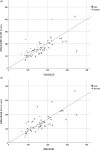Urinary iodine excretion and optimal time point for sampling when estimating 24-h urinary iodine
- PMID: 36744548
- PMCID: PMC10511680
- DOI: 10.1017/S0007114523000326
Urinary iodine excretion and optimal time point for sampling when estimating 24-h urinary iodine
Abstract
Iodine deficiency may cause thyroid dysfunction. The iodine intake in a population is measured by urinary iodine concentration (UIC) in spot samples or 24-h urinary iodine excretion (24UIE). 24UIE is considered the gold standard and may be estimated using an equation including UIC, urinary creatinine concentration, sex and age (e24UIE). The aims of this study were to evaluate the preferable timing of UIC when using this equation and assess the variability of UIE. Sixty healthy non-smoking women (n 31) and men (n 29) were included in Gothenburg, Sweden. Twelve urine samples were collected at six fixed times on two separate days. Variability was calculated for UIC, 24UIE, e24UIE, iodine excretion per hour (iHr) and UIC adjusted for creatinine and specific gravity. Median 24UIE was 156 µg/24 h and the median UIC (all spot samples) was 104 µg/l. UIC (P < 0·001), 24UIE (P = 0·001) and e24UIE (P < 0·001) were significantly higher in men. e24UIE was relatively similar to 24UIE. However, when e24UIE was calculated from UIC in the first void, it was about 15 % lower than 24UIE (P < 0·001). iHr was lowest in the morning and highest in the afternoon. Median iHr was higher in men (7·4 v. 5·3 µg/h, P < 0·001). The variability of UIE was higher within individuals than between individuals. This study suggests that most time points for estimation of individual 24UIE are appropriate, but they should preferably not be collected in the first void.
Keywords: 24-h urinary iodine excretion; Estimated 24-h urinary iodine excretion; Iodine; Sampling time; Urinary iodine concentration; Urine sampling; Variability.
Figures


Similar articles
-
24-Hour Urine Samples Are More Reproducible Than Spot Urine Samples for Evaluation of Iodine Status in School-Age Children.J Nutr. 2016 Jan;146(1):142-6. doi: 10.3945/jn.115.215806. Epub 2015 Nov 25. J Nutr. 2016. PMID: 26609173
-
[Assessment of iodine nutritional status for pregnant women using adjusted urine creatinine from spot and 24-hour urine].Wei Sheng Yan Jiu. 2018 Jul;47(4):548-553. Wei Sheng Yan Jiu. 2018. PMID: 30081979 Chinese.
-
Urinary iodine excretion (UIE) estimated by iodine/creatinine ratio from spot urine in Chinese school-age children.Clin Endocrinol (Oxf). 2017 Apr;86(4):628-633. doi: 10.1111/cen.13282. Epub 2016 Dec 7. Clin Endocrinol (Oxf). 2017. PMID: 27864986
-
The Use and Interpretation of Sodium Concentrations in Casual (Spot) Urine Collections for Population Surveillance and Partitioning of Dietary Iodine Intake Sources.Nutrients. 2016 Dec 23;9(1):7. doi: 10.3390/nu9010007. Nutrients. 2016. PMID: 28025546 Free PMC article. Review.
-
Salivary iodide status as a measure of whole body iodine homoeostasis?Br J Nutr. 2024 May 28;131(10):1740-1753. doi: 10.1017/S000711452400031X. Epub 2024 Jan 30. Br J Nutr. 2024. PMID: 38287697 Free PMC article. Review.
Cited by
-
Iodine intake and status of school-age girls in Ireland.Eur J Nutr. 2025 Jun 9;64(5):214. doi: 10.1007/s00394-025-03731-9. Eur J Nutr. 2025. PMID: 40488891 Free PMC article.
References
-
- Hetzel BS (1983) Iodine deficiency disorders (IDD) and their eradication. Lancet 2, 1126–1129. - PubMed
-
- World Health Organization (2007) Assessment of Iodine Deficiency Disorders and Monitoring Their Elimination: A Guide for Programme Managers, 3rd ed. Geneva: WHO.
-
- Zimmermann MB & Andersson M (2012) Assessment of iodine nutrition in populations: past, present, and future. Nutr Rev 70, 553–570. - PubMed
-
- Pearce EN, Andersson M & Zimmermann MB (2013) Global iodine nutrition: where do we stand in 2013? Thyroid 23, 523–528. - PubMed
-
- Zimmermann MB (2008) Methods to assess iron and iodine status. Br J Nutr 99, Suppl. 3, S2–S9. - PubMed
Publication types
MeSH terms
Substances
LinkOut - more resources
Full Text Sources
Medical

